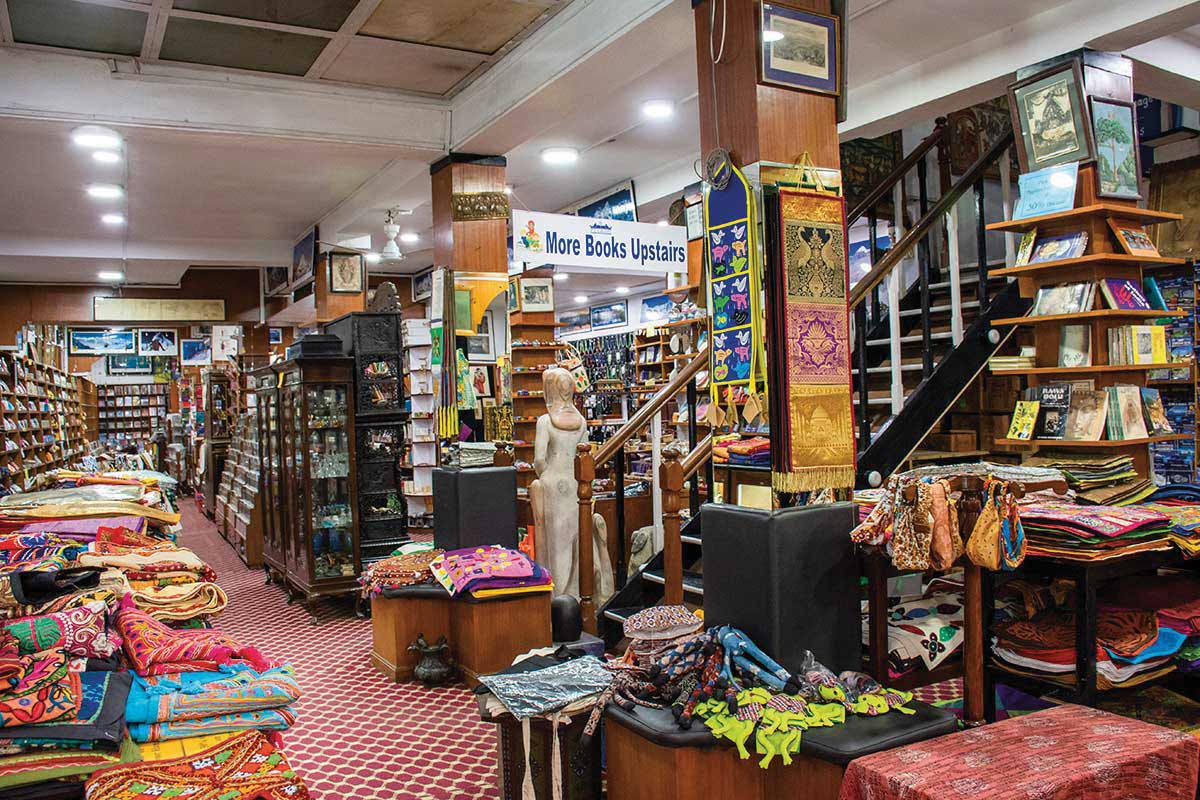The hardest part of overcoming adversity is continuing with things you had always done before. Yet this is what keeps us strong at the end of the day.
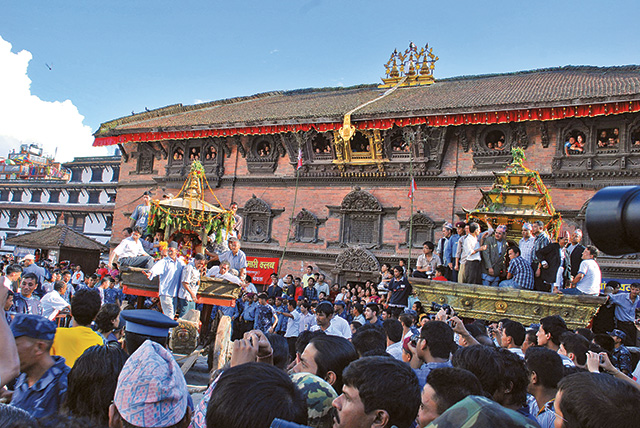
As Dangini prepares for a ritual prayer, she realises that she still needs a white flower, parijat, to offer during the worship. Like any mother would do, she asks her son, Indra, to run quickly to get her the flower. It was a simple wish, after all. The regent lord himself takes his vahan (the white elephant, Pulukishi) and sprints down to Kilagal where herds of animals grazed in a meadow and enjoyed idle afternoons. There he leaves his elephant behind and disguises himself as a farmer to sneak into Maru tole which was then a lush green garden.
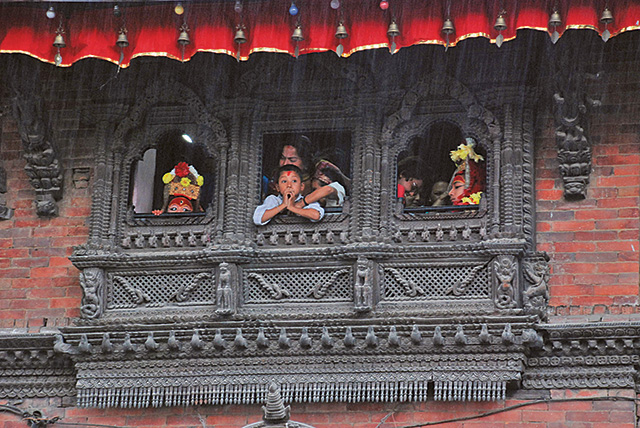
Indra Jatra is a famous festival that everybody probably knows about or has heard of. It is the festival where Dangini (mother of Lord Indra) runs while a crowd follows hot in her heels; the Rato Lakhe dances to excite everyone; the dashavatars (ten avatars) of Vishnu are reenacted; and the three living Gods are taken around the old city of Kathmandu. It is the festival where families sit together at the raised parapets of Maju Dega to watch the Goddess Kumari in her chariot; it is a festival where drumbeats and crashing cymbals reverberate throughout the city.
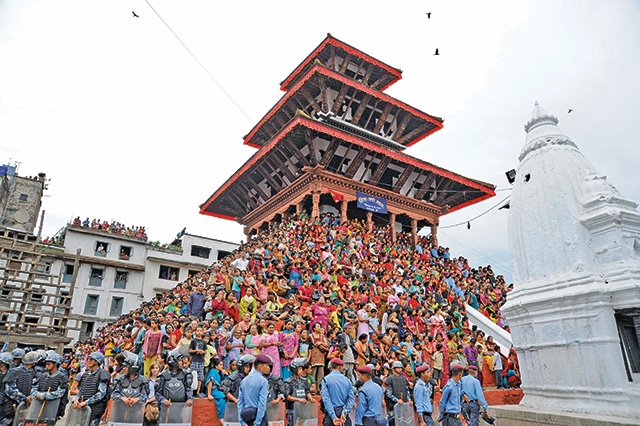
Last year, during Indra Jatra, I could hear my heart beat thump with the noise of the crowd. Eventually, because I was standing by myself, I was pushed to the back of the crowd just when the Kumari’s chariot pulled towards us. I could only catch a glimpse of her red robes from behind. And that was Indra Jatra for me. Lesson learnt: you can enjoy jatras only as a formidable group; but the greater lesson that I am just beginning to learn as we prepare for this year’s post-earthquake Indra Jatra, is that “the hardest part of adversity is continuing with things you had always done before, as that is what keeps us strong at the end of the day.”
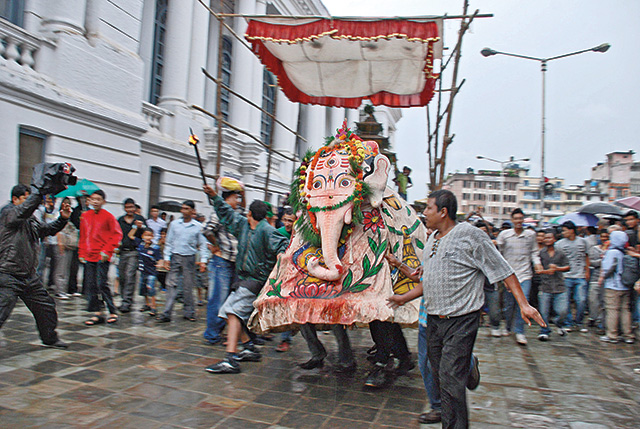
He warily takes his steps to return to his elephant, but before he finds his way, the mali (gardener) catches him. ‘Thief!’ He shouts and ensnares Indra in ropes.
Indra tries hard to free himself and begs for his innocence, but all is in vain. The mali, his family, and the locals are not ready to listen to him. To them, he is a thief and a liar, who has tried to steal the hard-earned wealth of a gardener.
Meanwhile, Dangini awaits for her Indra but he does not return. A day passes, and he still does not return. Another day passes, and there is still no sign of him. She cries out in the dark and runs madly to find her son. But no one can tell her where her son is.
Forecasting Indra Jatra
The recent earthquake has destroyed much in the old city of Kathmandu. The Maju Dega temple from where people would watch the spectacle of the Indra Jatra is now gone, the Trailakyo Mohan where the Dashavatar would be enacted is now in debris. The Kumari Ghar that still stands is now supported by heavy timber supports (tekas). And, the route the three chariots of the living gods were pulled through during the Indra Jatra is precarious with collapsed or unstable houses.
The effects of the earthquake can still be seen in Kilagal, where in a few days, the Pulukishi will run frantically to find his master. I look around the place to find the house with the Pulukishi mask to meet Chaitya Narayan Maharjan, the president of Kilagal Sahakarya. His office has cracks from the earthquake. I ask him, “Will the Jatra be held this year? Or are these just rumors that have taken over the city. How are the locals preparing for Indra Jatra?”
Chaitya Maharjan frowns at me as though I have offended him, but after a pause, answers, “The Jatra will continue, there is no stopping to that. We are all working towards it, but maybe we will have to shorten the Jatra. Though the country is in mourning, our Jatra is a way of continuing our culture. If we don’t continue in this difficult time, we would give time the opportunity to take away our heritage.”
With the changing times, many people have moved out of their houses in Kilagal, and yet they come together during every festival and jatra. “It is communities like ours that help in the continuity of our culture; if nobody would have taken the initiative of addressing the intangible connection with our tangible heritage, our culture would have died long before this quake. The earthquake of 1934 had destroyed everything, too, but our ancestors never stopped, though difficult, they persisted with the Jatra. Although we agree it’s a lot difficult now with more houses, all sorts of wires, and tekas, but there is no denying that the Jatra will happen.”
When our heritages collapse, we generally believe that things will never remain the same again. We forget that our ties run deeper than what is physical and tangible. And, maybe that is why people keep coming back to play their part in festivals and jatras. The intangible gives more meaning to them. “Our Kilagal guthi decides on the people responsible for the festival every year. My turn ended last year, and it was an opportunity for me because the turn comes only once in every generation. We have about 170 families under this guthi, and every year according to the turn of the families, eight people are given the main responsibility of the Pulukishi. Families who have moved out, come back to fulfill their responsibility, and the new generations learn every year about their culture through the Jatra,” says Chaitya Maharjan.
Dangini then descends down to earth herself to find her son. She finds her son bound with ropes. The people of Kathmandu had arrested him for his crime. She is bewildered, but yet humble. She promises the people enough dew for their winter crops, and ask for her son’s forgiveness. The people, realizing who they had captured, announce that they will send Indra back home with a huge celebration. And to witness it, they invite their Living Gods, Kumari, Ganesh, and Bhairav to bid him farewell.
 The hope the Jatra heralds
The hope the Jatra heralds
I remember standing on my toe with my camera last year, waiting for the little Red Goddess to appear from her royal house. People were standing on the dabalis, some were leaning on to the Gaddi Durbar. I had my camera around my neck, but I still couldn’t pull it up to take a picture because I was trapped inside the heavy crowd. But the festival was so profound and lively that I could still see the living gods through the many iPads raised in the air. I assumed this year would be the same, but with double the crowd I saw last year. However, with the Gaddi Durbar now under scaffolding, I doubt if that’s possible.
Nevertheless, Gautam Shakya, the chairperson of Indra Jatra Samiti and the caretaker of the Kumari Ghar, is rather more positive than I am. He is hopeful that the chariot will be wheeled down the streets, and celebrations will be joyful like they have always been. Even when I point out the obvious facts, such as the Gaddi Durbar being under scaffolding, and Trailokya Mohan’s fall, he does not look worried. Instead, he says, “Most of the costumes of the Dashavatar enactment were in a crushed and ripped state in the trunk that was stored inside the Trailokya Mohan Temple. Also in Halchowk, from where most of our mask dancers come, even though one of their families has lost loved ones in the earthquake, they still say the Jatra should continue and will continue.”
Time and again, the Indra Jatra management committee has been sitting together to discuss on how to conduct the Jatra post-quake. “We had surveyed the route for the chariots, on which our living gods Kumari, Ganesh, and Bhairav, will be taken around. Initially, we found that the roads were filled with tekas supporting damaged houses, but slowly people have started taking out the supports, and have been fixing potholes before the Jatra begins. The locals are helping in the best way they can - they too are keenly looking for solutions to get on with the festival,” adds Gautam Shakya.
“But I heard that the Jatra will be shortened. Is it true?” is my next question.
“I don’t think we will be shortening it. Once we take the journey, we have to complete it. Many people still believe that Nepal is not safe after the quake, but if we celebrate the festival, I believe we will be able to send the message that Nepal is safe for travel now. Even in this difficult time, if we continue our festivals, people outside will get to see how positive the people here are. The tangible has fallen, but the intangible still perseveres, and there is no reason to put a halt to this festival. We actually have 29 guthi khalas: playing their part. The earthquake has affected us all in some way or the other, but the right thing to do at this hour would be to persist like always.”
Arnold Adrian Bake, in a documenter of Indra Jatra, captured a time in 1931, when people watched the festival from Singha Sattal, Kasthamandap, and monuments that have now disappeared in the recent quake. About 83 years ago, people in dhaka topis and daura suruwals rejoiced in the Indra Jatra with the same enthusiasm that we witness every year. The British Library, in their archived documentary, stated, ‘Bake’s films represented a changing culture and a built landscape that would in part vanish with the earthquake of 1933,’ and it is true, parts of our culture and the built landscape do change and modify at certain intervals of time. However, some things remain the same, because we all understand that it is important to continue despite the things that happen to us. Our unravelling stories cannot stop because of one incident.
Days after the earthquake, the Home Ministry stated that 723 people were killed in Kathmandu alone. Rumors like ‘Kathmandu is a ghost town’ are still spinning around. And yet people are keenly waiting for Indra Jatra. Somehow, the Jatra has become a hope for people - a sign that things are getting back to normal. My fufu bajai (paternal grandfather’s sister) would often say to me, “Festivals should be celebrated even if we don’t want to. We may be going through difficult times, but learning to smile and share joy even when the time is tough is what makes us stronger.” She would sometimes bear the ritual fasting (in honor of the deceased) in our place, so that we could enjoy our festivals like nothing ever happened. I feel the earthquake has tied us all to this same story of moving on with what we have to do, despite tough times - sharing joy with the hope that things will get better.
And, until the time it really gets better, continuing with what we have to do is the best way to rebuild Nepal. So, while we arrest Indra in the heart of Kathmandu for eight days, let us keep our spirits up that the country will get stronger in these trying times.



